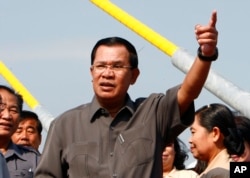Prior to her death on Thursday of last week, British architect Zaha Hadid was working to help Cambodia rebuild after the tragedies of its history.
As was well-known, she was designing a new institute in Phnom Penh to foster research and remembrance of the country’s darkest hours under the Khmer Rouge. However, she also possessed a more obscure aspiration: to create an architectural master plan for the capital itself.
Born in Iraq, Hadid astonished the world with her signature designs characterized by the use of curves. In 2004, she became the first woman to win the coveted Pritzker Architecture Prize.
Her achievements included the Vitra Fire Station in Germany, the Richard Rosenthal Center for Contemporary Art in Cincinnati, Ohio, Rome’s MAXXI Art museum, the Guangzhou Opera House and the Aquatics Center for London’s 2012 Olympics.
In 2014, she unveiled the designs for Phnom Penh's Sleuk Rith Institute at the behest of Youk Chhang, executive director of the Documentation Center of Cambodia. But that project—the design for which is now finished—spawned a broader interest in the region.
Although she never set foot in Cambodia, Hadid had a vision of making Phnom Penh an improved, healthier place for inhabitants, according to Chhang. With that in mind, she decided voluntarily to work on plans for the capital city's development over the coming decades.
“She thought that the first thing to do was a specific master plan that is usable rather than imaginative,” Chhang told VOA Khmer.
She wanted to draw on the presence of the city’s converging Mekong and Tonle Sap rivers to create a “balance”— preserving historic areas while accelerating development in the city center, said Chhang, explaining the late designer’s vision.
“Due the lack of budget in the government, she worked on this voluntarily,” Chhang said, adding that Hadid wanted to submit the proposal regardless of whether the government was already working with another company.
“She just thought: it’s not too late for this project, which would last until 2050," Chhang said. "She wanted [a plan to make] this city the best place possible, and then submit it to the government.”
But such an ambitious plan would require support of Cambodia’s government and ultimately Prime Minister Hun Sen. Hadid made an official request and received permission in a letter from Minister of Education, Youth and Sport Hang Chuon Naron to engage with the Phnom Penh municipality.
Ministry spokesperson Ros Salin confirmed that a group attached to Hadid’s company had been working with the Phnom Penh Municipality, as well as the Ministry of Land Management, Urban Planning and Construction, but said he didn’t know what whether progress was made.
Phnom Penh Governor Pa Socheatevong said cooperation was limited.
“They only had a plan to study and assist in the field of urban planning,” he said. “There are just researchers who help organize our master plan. That’s all what we have discussed so far.”
'Very complicated' city
Local urban campaigners said the city’s administration could do with help from an international design firm like ZHA, which had painted a picture of Phnom Penh—with a population of 3 million people—at a breaking point after years of poorly planned development.
The city’s expansion, said Ee Sarom, executive director of the group Sahmakum Teang Thnaut, which advocates habitat rights, has left many residents worse off. Particularly disastrous was the plan to build a high end real estate development on the site of the former Boeng Kak lake by the ruling party-linked company Shukaku Inc. The lake itself was pumped full of sand, and the surrounding community was displaced in a mass eviction that sparked the country’s most high-profile land dispute.
Some of the 4,000 former residents who say they were not properly compensated have been protesting—enduring police beatings and repeated arrests—for years.
“We support a redesign, a better master plan, because we previously saw there were a lot of impacts," said Sarom, referring to the government’s slapdash planning efforts. "The buildings are tall at some places, while at other places they are short; some places are filled with too much land, while the other places are flooded. It’s very complicated in Phnom Penh.”
Hadid’s sudden death from a heart attack at 65, said DC-Cam’s Youk Chhang, has not killed her vision for a better Phnom Penh.
“Her team is still working on the master plan at her own cost, and I am hoping to use it to convince the city governor and the government of Cambodia,” he wrote in an email.
Cambodia, he added, has lost a rare and valuable ally.
“We lost a good friend, because Cambodia is a country she wholeheartedly helped,” he said.
This report was produced in collaboration with VOA's Khmer Service.











